Trench Digging
Dig a Trench by Hand: Why and how you should do it.
Author: Greg Baka

Keep reading, or jump directly to these sections:
- Why to Trench by Hand Instead of Using Machinery
- How to Dig a Trench by Hand
- The Best Tools for Trench Digging
- Hand Digging (a general guide)
Manual trenching involves the use of human muscle to break up or loosen soil, then lift or drag it up out of the trench. It is done using a small assortment of specialized hand tools designed for different conditions.
Both narrow and wide trenches can be dug by hand. Narrow trenches are for utilities like water or electrical lines.
Wider trenches are for construction or drainage (see our
Why to Trench by Hand Instead of Using Machinery
Manual trenching is still essential for the following three reasons:
- The geometry of the trench (Length, Width, and Depth)
- Access to the area
- Beginning and end of trenches
Geometry of the Trench
The length of a trench is one deciding factor between digging a trench by hand and using a powered trencher or excavator. For long trenches, it usually pays to use powered machinery. But for short trenches, manual digging is often more efficient and cost effective.
The width and depth of a trench combine to become another deciding factor between trenching manually or with power equipment. When the width is small and the depth is large, it is wise to use a trencher because it is very difficult to dig with a narrow shovel in deep trench. When the width is large and the depth is deep, it is also wise to use a powered excavator – primarily because of the large amount of soil that must be moved up and away from the trench. Digging a trench by hand is more effective in cases when both the width and depth are small or medium, and for wide trenches of small or medium depth.
Access to the Area
Access to the area is sometimes a factor in the choice between trenching by hand and using powered equipment. Many yards are not accessible to large trenching equipment, without removing fences and damaging landscaping. Though there are small walk-behind trenchers that will fit through most gates. While digging a trench by hand is possible in the tightest of areas as well as in wide open spaces.
Beginning and End of every trench
There are limitations to how close powered trenching equipment can get to structures that result in some
manual trench digging being required even on jobs done with powered equipment. Also see our
The beginning and end of a trench made with powered equipment usually require digging by hand to complete them. This is because trenches often stretch from one structure to another, and a chain type trencher has some limitation on how close to a structure it can start, and a much larger limitation on how close the chassis of the trencher can back up to the target structure. So after the middle length of a trench is cut with a conventional powered trencher, manual trench digging is needed to extend it to the desired origin and then to the final target.
How to Dig a Trench by Hand
Manual trench digging is much like the general hand digging process. It requires two steps:
Step 1: The first step is to break up or loosen the soil.
Step 2: The second step is to move the soil, either by scooping up the loose soil and lifting it vertically out of the trench, or by dragging the loose soil up a ramp in the trench to the surface.
These two steps or actions are different enough that they are usually done with separate tools. But the “drag the soil up a ramp” method can all be done with a trenching hoe or grub hoe.
Step 1: Breaking up or loosening the soil in the trench

Breaking up and loosening soil in a trench is done either by slicing, impacting, or prying.
- Slicing is normally done with a trench digging shovel, either by pushing it in with your foot or arms. In a narrow 4 inch trench, it becomes difficult to press with your foot once the trench gets much deeper than 18 inches.
- Slicing with a mattock or grub hoe is done by chopping into soil at the bottom of the trench.
- Impacting is done with a tool like a pick, mattock, or digging bar. It is done for hard compacted soil or soil mixed with a lot of gravel.
- Prying loosens the soil by stabbing a pick or digging bar deeply into the soil and then prying with the tool to raise and fracture the soil upwards. Using a long digging bar makes digging deep trenches much easier.
If you run into obstacles like roots or rocks, see our Roots and Rocks article to learn how to deal with them.
Step 2: Moving the soil out of the trench

- Lifting the loose soil up and out is done with a trench clean-out shovel or with a special scoop like our Bottom Digger. A trench clean-out shovel has a very large angle between the handle and shovel blade (meaning the scoop shovel has a very high lift) so the user doesn't have to bend over as far to reach the bottom of the trench.
- Dragging the loose soil up a ramp with a trenching hoe or grub hoe involves digging the trench so that there is always a ramped area leading to the surface. The hoe is used to loosen the top layer of the ramp, and then that loose soil is dragged up and out. So the ramp slowly moves down the length of the trench. See the diagram below.

The Best Tools for Trench Digging
As mentioned earlier, the basic process of digging a trench by hand is to loosen or break up the soil, then scoop it up or drag it up and out of the trench. If you are digging a wide shallow trench (like a ditch), then the tools shown in our Hand Digging article will work well. But if you want to make a trench that is narrow or deep, check out the options below.
Manual tools for breaking up the soil
Trench Digging Shovel


Grub Hoe or Digging Hoe

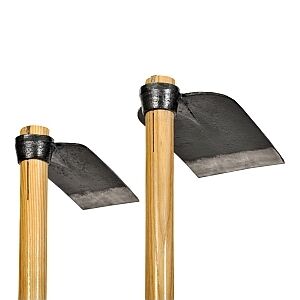
Pick and Mattock

- Pick Mattock – one end has a long point for piercing hard soil and busting rock, while the opposite end has a short digging blade for chopping up soil.
- Cutter Mattock - one end has an axe blade for chopping through roots, while the opposite end has a short digging blade for chopping up soil.
- Pickaxe – this tool is usually heavier than a mattock and either has pick points on both ends or a pick point on one end and a horizontal chisel blade about one inch wide on the opposite end. It is used for busting up rocks, stone, and really hard soil. It can also be used for prying out rocks.
Digging Bars
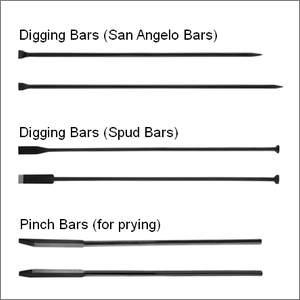
- San Angelo Bar – this digging bar has a tapered point on one end like a pick point. It has a narrow chisel blade on the opposite. It is used for hard soil that contains rocks and stones.
- Spud Bar – this digging bar has a wide sharp digging blade on one end and a tamping head or disc on the opposite end. It gets used for digging post holes and cutting roots. The tamping end is for compacting soil back in around fence posts.
- Pry Bar or Pinch Bar – this long heavy bar is hard to bend. It is used for prying up rocks or even broken concrete.
Sharpshooter Shovel


The narrow round tip does penetrate sad and soil fairly easily. It is limited to trenches 6 inches wide and up to 18 inches deep.
It is available in long and short handled versions. It's also called a Drainage Spade or a Tile Spade.
See the
Manual tools for moving soil out of the trench
Moving loose soil out of the trench means either scooping and lifting it out, or dragging it up and out. For narrow or deep trenches, there are only three tools made for this task and they are listed below.
Trench Clean-out Shovel
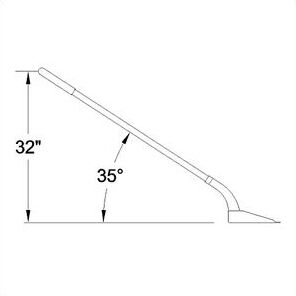

“Bottom Digger” Trench Clean-out Scoop
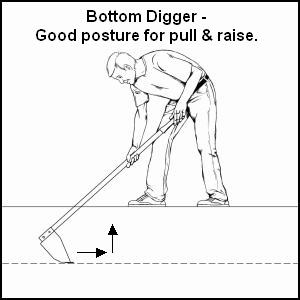
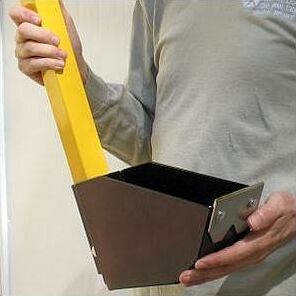
Grub Hoe or Digging Hoe


See the description and diagram above.
See the
In closing, we hope this information about manual trench digging was useful, and that you found some new ideas for your next project. Before we wrap up, we wanted to share our article showing a variety of Storage Methods for Long Handled Tools so that you can keep digging tool collection safely organized.
Please do remember us for your next tool purchase.

